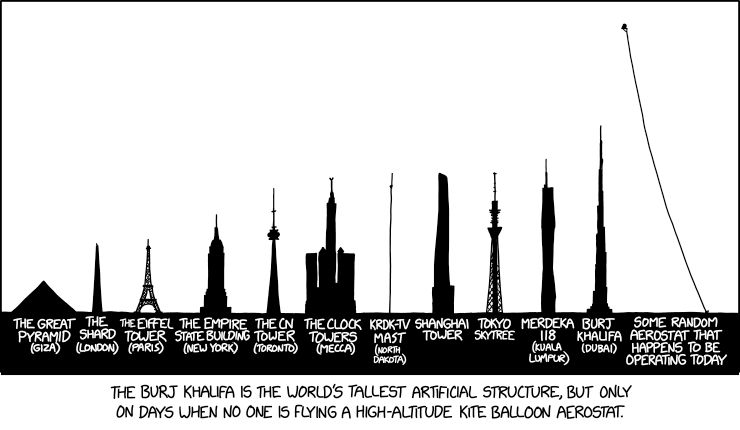Tall Structures

Briefly set a new record for tallest human-made structure by getting my knit sweater snagged on the skydiving plane door as I jumped and not noticing until I'd landed.

Briefly set a new record for tallest human-made structure by getting my knit sweater snagged on the skydiving plane door as I jumped and not noticing until I'd landed.
This is a comparison of various tall buildings and other structures, ranging from the largest pyramid of Giza to the Burj Khalifa, sorted by increasing height. It mimics common illustrations of successive tallest buildings/structures in the world through time, or the current 'top few' examples, but instead represents an idiosyncratic selection. The pyramid of Giza was the tallest structure in the ancient world, and the Burj Khalifa is broadly acknowledged as the tallest building in the world.
When comparing the tallest structures of various types, the question of definitions often becomes important. Some define the heights of buildings to their highest occupied floor, while others (including all permanent structures) may include merely-aesthetic spires or have arbitrary installations of antennae on top of the building (which may comprise a significant portion of the building's height). Potentially all of an uninhabited and sealed pyramid could be considered structure alone, with any of its internal voids left unusable, practically inaccessible and definitely beyond sight.
There's also the question of whether structures need to be self-supporting to be counted, since structures such as antennae may be extremely tall but only stay up with the help of guy-wires. In this comic, Randall seems to take the broadest possible definition, apparently defining a "structure" as any artificial construct with continuous extent from the ground to its height. The comic then demonstrates how ludicrous such a broad definition becomes, by portraying a "random aerostat", tethered to the ground by a long cable, which is by far the tallest structure on the chart, significantly exceeding the height of the Burj Khalifa.
An aerostat is a lighter-than-air aircraft that can be tethered to the ground. A kite balloon (or kytoon) is a variant of the aerostat where the balloon body includes a lifting-body or kite design for additional lift. It is more stable than a balloon in winds and tends to hold its position above the tether. This is the main joke of the comic, since as long as it is tethered to the ground and is higher than the Burj Khalifa, it could be considered the tallest man-made structure. Since aerostats (and similar tethered flying objects) are generally not counted as "structures", this points out that, without agreed-upon and restrictive definitions, the question of what's tallest quickly becomes meaningless. There is a class of structures, typically seen in oil platforms, that are "medium supported" and that use buoyancy to stand 'tall' above their anchored deep-sea end in an otherwise freestanding manner; there are clear parallels to the concept of a tethered balloon, and one such structure had indeed been touted by some as the "tallest free-standing structure" up until the Burj Khalifa physically surpassed it.
The comic doesn't accurately depict the world record for how high tethered aerostats can actually fly (4880 meters, achieved on 23 September 2014, close to 6 times the height of Burj Khalifa), which would either dwarf the other buildings or make the comic very tall, but since it is just some random aerostat flying at that time that is shown, this may be at a much lower height.
The title text takes this point even further, claiming that Randall once skydived out of an airplane wearing a knit sweater, which caught on the airplane door, and presumably unraveled as he descended. The implication being that the yarn unraveled without breaking during his entire descent. When he reached the ground, the long thread presumably extended from his body up to the plane (typically 2,400–4,300 m, or 8,000–14,000 feet, above the ground). For the tiny moment between when he hit the ground and when the thread snapped or came loose (since the plane would still be moving), this would "briefly" form a structure, under the broadest possible definition, and would therefore set a new record. This is obviously not realistically feasible. Even if a thread could remain intact and connected under such circumstances, most knit tops don't have nearly enough thread to reach that kind of height. Unless, of course, you chose to ignore the implicit requirement that one end be anchored to the Earth or jumped from a plausible but unusually low height, on a day without particularly formidable aerostat competition.
Table of structures in the comic
Name Height Tallest structure Explanation The Great Pyramid (Giza) 137 m (449.5 ft) c. 2570 BCE–1311 CE A famous pyramid built c. 2570 BC The Shard (London) 309.6 m (1,016 ft) – A skyscraper with steeply angled sides, the tallest 'habitable freestanding structure' in the UK. The Eiffel Tower (Paris) 330 m (1,083 ft) 1889–1930 A wrought-iron lattice tower named after its designer, Gustave Eiffel The Empire State Building (New York) 443.2 m (1,454 ft) 1931–1967 An art-deco office tower often seen in media The CN Tower (Toronto) 553.3 m (1,815 ft) 1975–2007 A communication and observation tower in Canada The Clock Towers (Mecca) 601 m (1,972 ft) – A hotel complex featuring the largest clock in the world KRDK-TV mast (North Dakota) 630 m (2,060 ft) – Current tallest structure in the United States (KVLY-TV mast was previously taller) Shanghai Tower (Shanghai) 632 m (2,073 ft) – Tallest skyscraper in China Tokyo Skytree (Tokyo) 634.0 m (2,080 ft) – Tallest tower in the world Merdeka 118 (Kuala Lumpur) 678.9 m (2,227 ft) – A skyscraper with diamond-shaped facades Burj Khalifa (Dubai) 828 m (2,717 ft) 2007–present Tallest structure in the world Some random aerostat that happens to be operating today ~1,280 m (4,200 ft) (Depicted)
~4,600 m (15,000 ft) (Actual)Varies The main joke in the comic